John dalton - Study guides, Class notes & Summaries
Looking for the best study guides, study notes and summaries about John dalton? On this page you'll find 257 study documents about John dalton.
Page 3 out of 257 results
Sort by
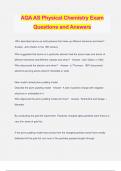
-
AQA AS Physical Chemistry Exam Questions and Answers
- Exam (elaborations) • 45 pages • 2024
-
- $13.49
- + learn more
AQA AS Physical Chemistry Exam Questions and Answers Who described atoms as solid spheres that make up different elements and when? - Answer- John Dalton in the 19th century Who suggested that atoms of a particular element had the same mass and atoms of different elements had different masses and when? - Answer- John Dalton in 1803 Who discovered the electron and when? - Answer- JJ Thomson, 1897 discovered electrons proving atoms weren't indivisible or solid. New model named plum puddin...
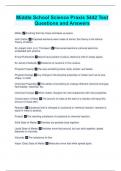
-
Middle School Science Praxis 5442 Test Questions and Answers
- Exam (elaborations) • 9 pages • 2024
-
Available in package deal
-
- $9.49
- + learn more
Matter Anything that has mass and takes up space. John Dalton Proposed elements were made of atoms; this theory is the Atomic Theory of Matter. Sir Joseph John (J.J.) Thompson Discovered electrons; pictured electrons embedded with protons. Ernest Rutherford Atoms have positive nucleus; electrons orbit in empty space. Sir James Chadwick Existence of neutrons in the nucleus. Physical Property The way something looks, feels, smells, and tastes. Physical Change Any change to the ph...
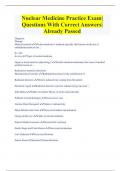
-
Nuclear Medicine Practice Exam| Questions With Correct Answers| Already Passed
- Exam (elaborations) • 14 pages • 2024
- Available in package deal
-
- $11.49
- + learn more
Nuclear Medicine Practice Exam| Questions With Correct Answers| Already Passed Diagnosis Therapy Medical research Nuclear medicine is meducal specialty that focuses on the use of radiopharmaceuticals for ... In- vitro In-vivo Types of nuclear medicine Organ or tissue function (physiology) Nuclear medicine determines the cause of medical problem based on ... Radioactive material (detection) Pharmaceutical (carrier) Radiopharmaceutical is the combination of Radiation detectors Det...
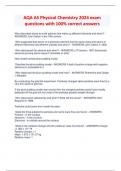
-
AQA AS Physical Chemistry 2024 exam questions with 100% correct answers
- Exam (elaborations) • 29 pages • 2024
- Available in package deal
-
- $13.99
- + learn more
AQA AS Physical Chemistry 2024 exam questions with 100% correct answers Who described atoms as solid spheres that make up different elements and when? - ANSWERS John Dalton in the 19th century Who suggested that atoms of a particular element had the same mass and atoms of different elements had different masses and when? - ANSWERS John Dalton in 1803 Who discovered the electron and when? - ANSWERS JJ Thomson, 1897 discovered electrons proving atoms weren't indivisible or solid. New m...
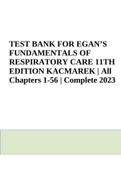
-
TEST BANK FOR EGAN’S FUNDAMENTALS OF RESPIRATORY CARE 11TH EDITION KACMAREK | All Chapters 1-56 | Complete 2023
- Exam (elaborations) • 1029 pages • 2023
-
- $38.49
- 1x sold
- + learn more
TEST BANK FOR EGAN’S FUNDAMENTALS OF RESPIRATORY CARE 11TH EDITION KACMAREK | All Chapters 1-56 | Complete 2023. Who is credited with first describing the law of partial pressures for a gas mixture? a. John Dalton b. Joseph Prestley c. Jacque Charles d. Thomas Young ANS: A John Dalton described his law of partial pressures for a gas mixture in 1801 and his atomic theory in 1808. DIF: Recall REF: p. 7 OBJ: 2 7. Who was the first scientist in 1865 to suggest that microorganisms caused m...
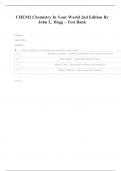
-
CHEM2 Chemistry In Your World 2nd Edition By John L. Hogg
- Exam (elaborations) • 52 pages • 2023
-
- $9.99
- + learn more
CHEM2 Chemistry In Your World 2nd Edition By John L. Hogg – Test Bank Chapter 3 MULTIPLE CHOICE 1. Which combination of individual and contribution is not correct? ANS: D 2. John Dalton did his research work in which of the following countries? ANS: D 3. Which radiation type has no detectable charge? ANS: C 4. Which radiation type was shown to be identical to N electron? ANS: B 5. Ruthe...
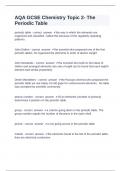
-
AQA GCSE Chemistry Topic 2 Question and answers correctly solved 2024
- Exam (elaborations) • 4 pages • 2024
-
Available in package deal
-
- $12.49
- + learn more
AQA GCSE Chemistry Topic 2 Question and answers correctly solved 2024 periodic table - correct answer the way in which the elements are organized and classified. Called this because of the regularlly repeating patterns. John Dalton - correct answer the scientist who proposed one of the first periodic tables, he organized the elements in order of atomic weight John Newlands - correct answer the scientist who built on the ideas of Dalton and arranged elements into sets of eight (as he...
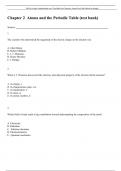
-
Test Bank for Chemistry Atoms First 2nd Edition by Burdge latest complete A+ graded
- Exam (elaborations) • 72 pages • 2023
-
- $16.09
- + learn more
Test Bank for Chemistry Atoms First 2nd Edition by Burdge latest complete A+ graded Chapter 2 Atoms and the Periodic Table (test bank) Student: 1. The scientist who determined the magnitude of the electric charge on the electron was A. John Dalton B. Robert Millikan C. J. J. Thomson D. Henry Moseley E. J. Burdge 2. When J. J. Thomson discovered the electron, what physical property of the electron did he measure? A. its charge, e B. its chargetomass ...
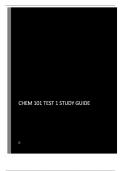
-
CHEM 101 TEST 1 STUDY GUIDE
- Other • 7 pages • 2024
-
Available in package deal
-
- $10.99
- + learn more
law of conservation of mass - Answer - in a chemical reaction, matter is neither created nor destroyed theory - Answer - a well-established hypothesis what is the difference between a law and a theory? - Answer - a law summarizes a series of related observations while a theory gives underlying reasons for them quantifiable data - Answer - -objective in nature -measurable -uses equipment qualifiable data - Answer - -subjective in nature -observational -colors, shapes, ect ...
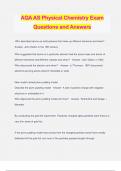
-
AQA AS Physical Chemistry Exam Questions and Answers
- Exam (elaborations) • 45 pages • 2024
-
- $13.49
- + learn more
AQA AS Physical Chemistry Exam Questions and Answers Who described atoms as solid spheres that make up different elements and when? - Answer- John Dalton in the 19th century Who suggested that atoms of a particular element had the same mass and atoms of different elements had different masses and when? - Answer- John Dalton in 1803 Who discovered the electron and when? - Answer- JJ Thomson, 1897 discovered electrons proving atoms weren't indivisible or solid. New model named plum puddin...

How much did you already spend on Stuvia? Imagine there are plenty more of you out there paying for study notes, but this time YOU are the seller. Ka-ching! Discover all about earning on Stuvia


